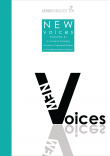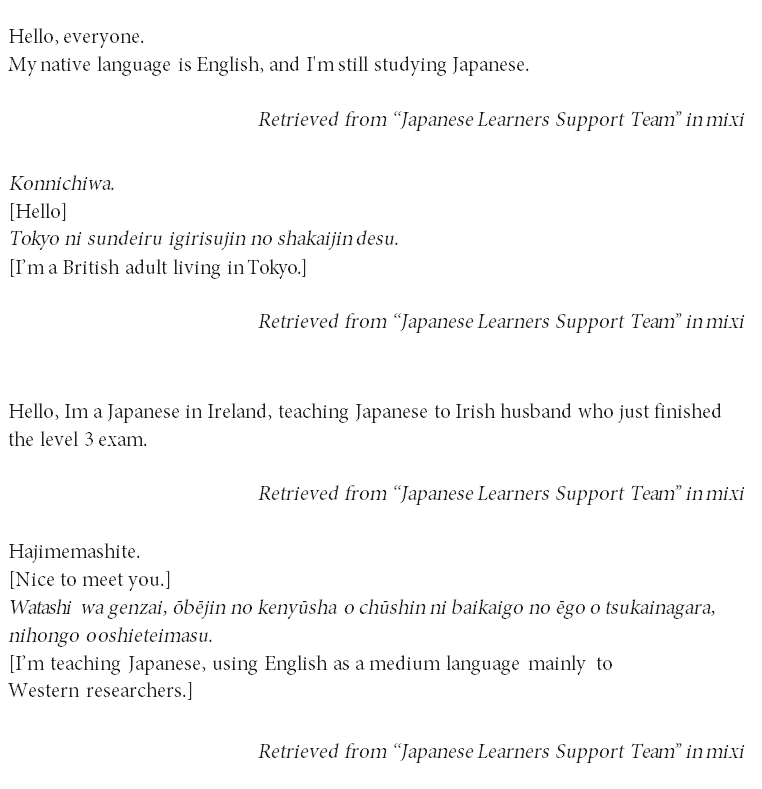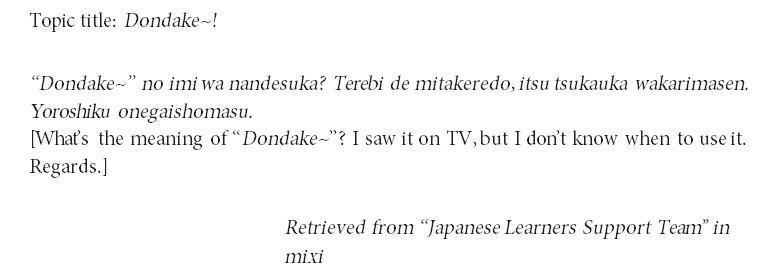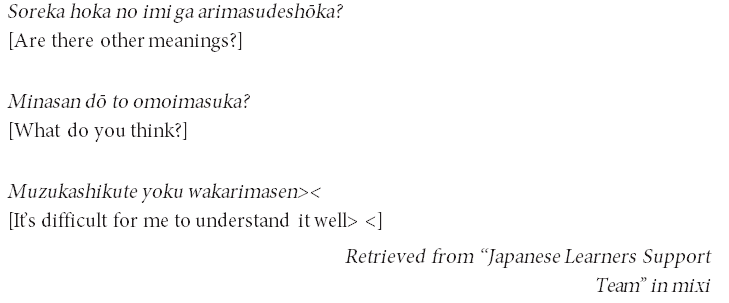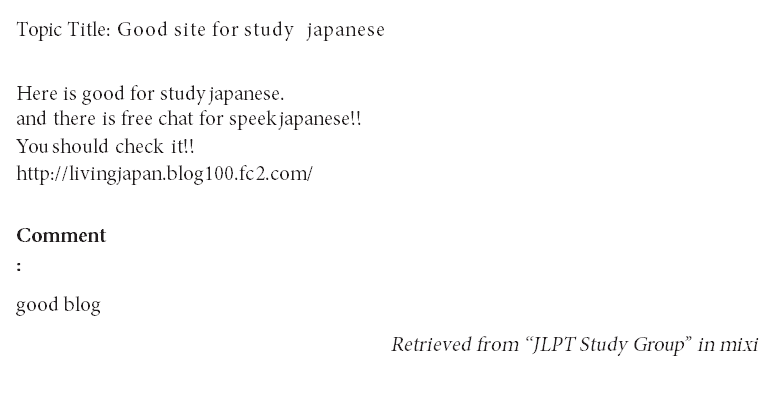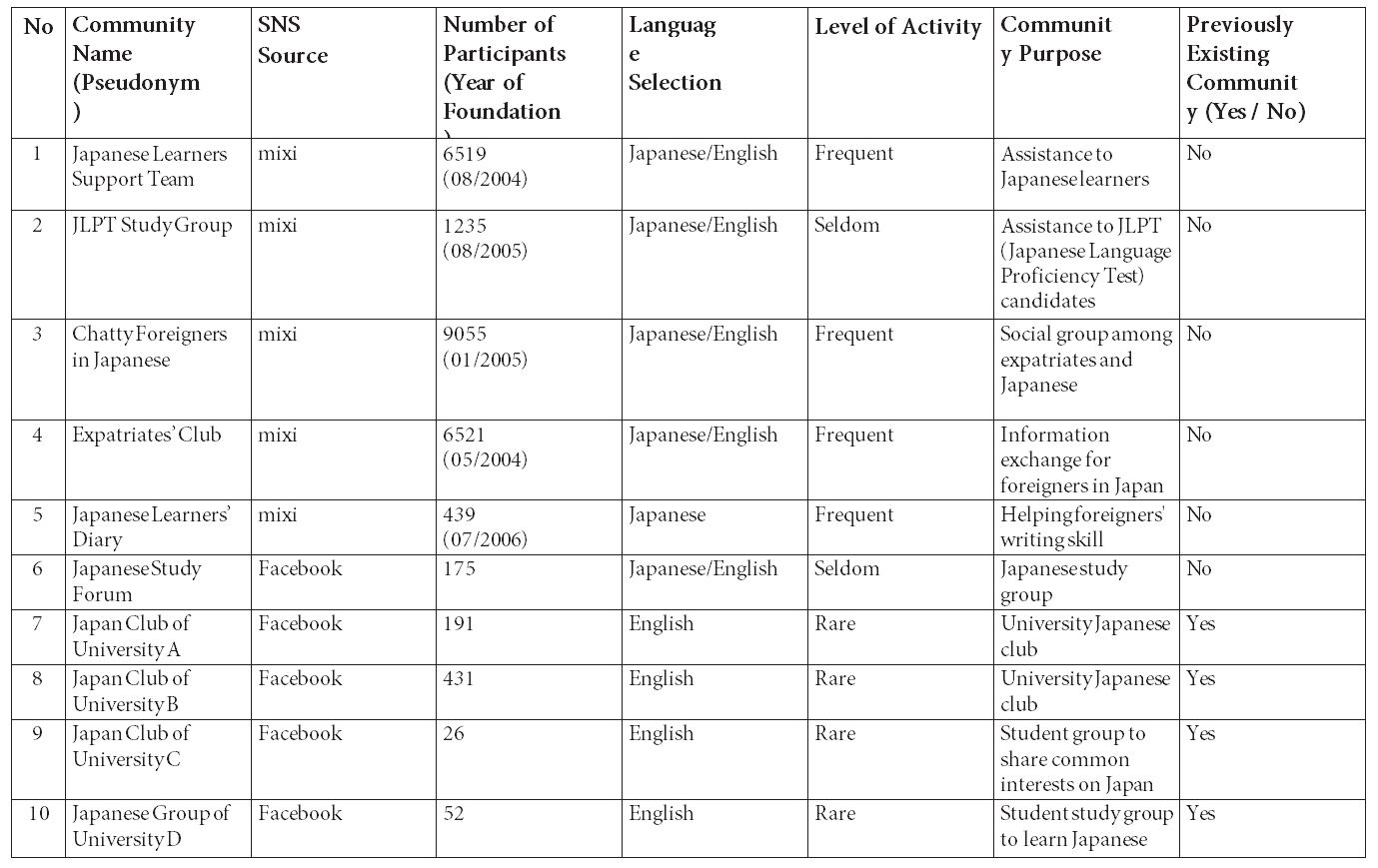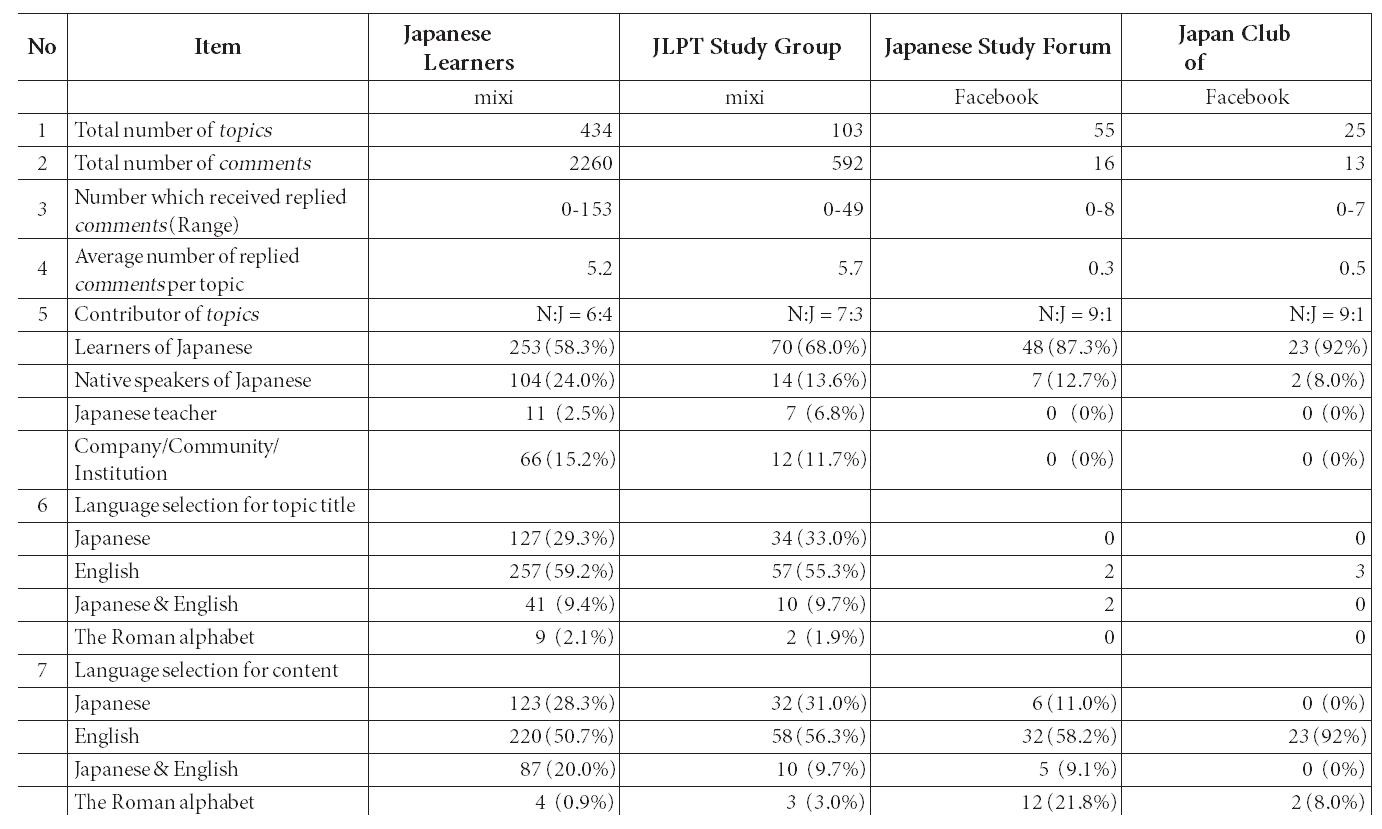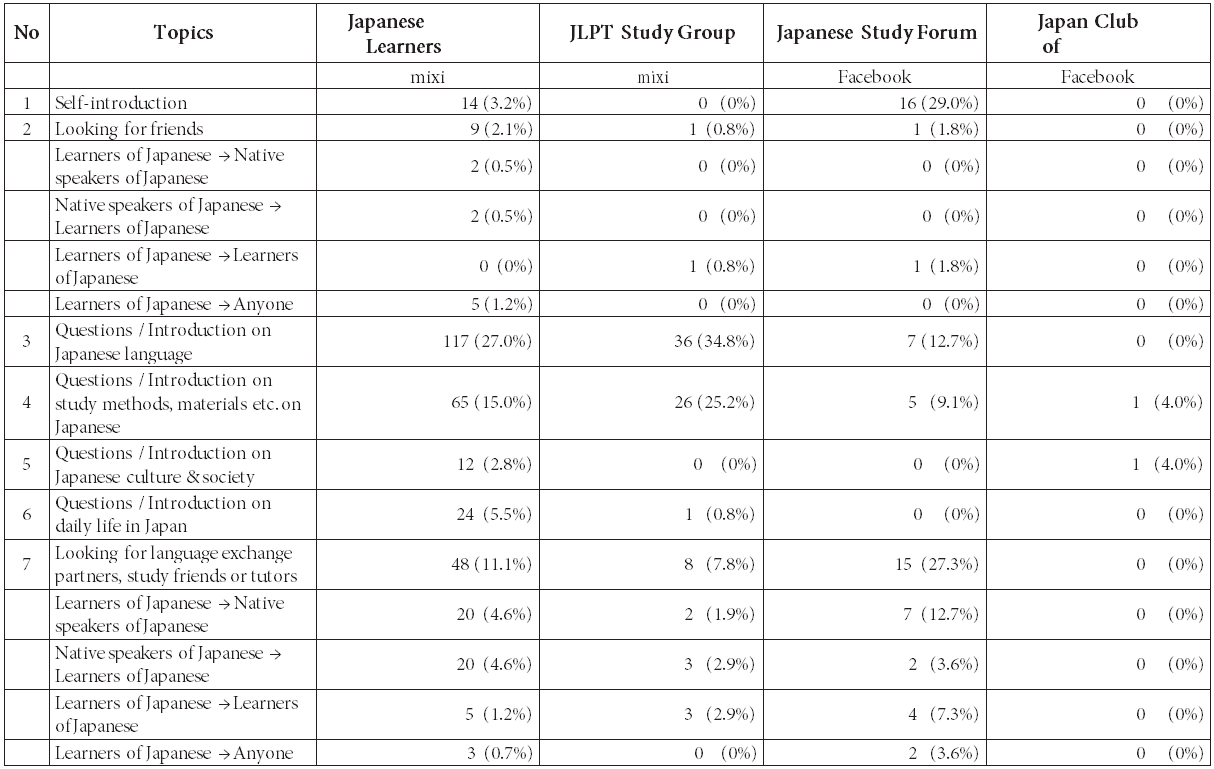A Study of Social Networking Sites for Learners of Japanese
Published January, 2011
Pages 144-167
DOI: http://dx.doi.org/10.21159/nv.04.07
New Voices
Volume 4
© The Japan Foundation, Sydney, 2011
Permalinks for references are available in the HTML version of this article.
Abstract
Social Networking Sites (SNSs) such as ”Facebook” and ”MySpace” have been used by many people from different countries around the world, and they have recently been applied to second language (L2) learning, both inside and outside classrooms. A number of researchers have investigated the utility of SNSs, and some language researchers have studied the use of SNSs for L2 learning in language classrooms. However, the study of the usage of SNSs for L2 learning outside the classroom has not yet been studied thoroughly, despite the fact that many communities and groups exist for users who are interested in learning L2 on such sites.
This article examines the nature and extent of SNS communities available specifically for L2 learners of Japanese, and describes the usage which is being made of these communities in particular on the SNSs, ”mixi” and ”Facebook”. Furthermore, the beneficial aspects of using such sites for L2 learning will be discussed.
Introduction
Language learning approaches, both inside and outside the classroom, have been changing along with advances in technology. Educational institutions and language learners are getting the benefits from the flexibility and accessibility offered by computer technologies.1 Such technologies allow second language (L2) learners to access the Target Language (TL) easily, especially outside the classroom. For example, learners have the opportunities to access authentic language usage or enrich their knowledge of culture and society through reading the TL on websites, listening to music or watching TV programs in the TL, and so forth. Interaction with native speakers of the TL by using Computer Mediated Communication (CMC) tools such as Social Networking Sites (SNSs) or instant messenger is also now possible. Moreover, non-native speakers can interact with other non-native speakers who speak the same L2 through CMC tools. Such interactions through computer technologies provide many opportunities for information exchange and L2 development.2
One of the CMC tools, SNSs such as ”Facebook” and ”MySpace” have been used by many people all over the world, and have recently infiltrated our daily life. On such sites, there are many communities and groups which exist for users who are interested in communicating in or studying the L2. Many researchers have investigated the utility of SNSs, and some language researchers have studied the use of SNS for L2 learning in language classes.3 However, the study of SNSs usage for L2 learning outside the classroom has not yet been paid much attention. Consequently, the present study will examine the nature and extent of SNS communities available specifically for L2 learners of Japanese, and describe the usage which is being made of these communities, in particular on the SNSs, ”mixi” and ”Facebook” which are the most popular SNSs in Japan and internationally. Furthermore, the beneficial aspects of using such sites for L2 learning will be discussed.
This study has been based on three research questions:
- What types of communities designed for L2 learners of Japanese exist in ”mixi” and ”Facebook”?
- How are those SNS communities used by learners?
- What are the beneficial aspects for L2 learning particularly in SNS communities?
Background study
Only a few studies have explored the use of SNSs for L2 learning, thus, I will also review the literature that covers the factors that support language learning, which are relevant to the use of CMC. The following discussion is organised under features which have been suggested as being important for language learning, specifically, peer assistance, authenticity, gratification of social needs, and anonymity.
It has been suggested that interactions through SNSs among peer networks provide an ideal environment for beginning L2 learners to enhance their literacy, promote academic rigour, and involve the participation of learners from a variety of different backgrounds, as well as encouraging active learning and purposeful practice.4 Peer assistance, in face-to-face contexts, has been widely investigated in recent years. Vygotsky highlights the different degrees of accomplishment by individuals who have the help of teachers or more capable peers.5 Although learners have limited ability to solve problems by themselves, they can exceed their limitations and reach higher levels of performance with teachers’ or peers’ assistance. The gap between what they can achieve on their own and with assistance is termed the Zone of Proximal Development (ZPD) and Vygotsky considers that it constitutes a generative potential for learning. Consequently, it can be expected that peer assistance may provide appropriate scaffolding for L2 learning.6 Swain and Lapkin propose that collaborating with peers could develop better L2 learning processes through learners (1) noticing what they do not know, (2) forming and testing hypotheses, (3) using unknown language by producing before comprehending (4) talking themselves into understanding, and (5) co-constructing language or linguistic knowledge.7 From these points of view, Swain affirms that peer interaction could foster cognitive learning.8 Similarly, Skon, Johnson and Johnson point out that co-operative peer assistance generates higher quality cognitive learning.9 They examined the effects on language acquisition of cognitive reasoning strategies by contrasting co-operative peer assistance and individual efforts. As a result, the study concludes that co-operative peer assistance promotes higher achievement than individual efforts.10
The various functions in SNSs enable the language learners to input authentic TL by reading, watching and listening to practical TL usage, and also to have opportunities to output what they have learnt through such applications.11 As another prominent feature of SNSs, Goertler points out that SNSs enable learners to access interlocutors who are not usually available in the traditional face-to-face classroom- based learning environment, such as native speakers of the TL.12 Therefore, Goertler identifies that such new CMC technologies are significantly valuable for L2 learners, not only for obtaining authentic materials but also because learning the way of native speakers’ language usage could sustain learners’ interests in the TL.13
Importantly, the role of SNSs in the gratification of social needs should be carefully considered. SNSs are not created as a language learning device, and their basic function is for socialisation purposes. Ebersole points out that SNSs can motivate the users because the social nature of online networking lends itself to gratification of social needs.14 From this point of view, it could be expected that not only language acquisition but also gratification of social needs might sustain L2 learners’ motivation. Dixon considers that the gratification of social needs is an essential element to maintain motivation, and new communication services have replaced older media for this reason.15 Thus, the gratification of social needs which could be obtained through interactions in SNSs would be an important supplemental element to support and enhance the learners’ enthusiasm toward L2 learning.
Another characteristic of CMC is the use of anonymity. According to Kern, anonymity creates a certain distance between the participants that may contribute to an atmosphere of critical receptivity and it enhances language production.16 In other words, the vast anonymity of cyberspace gives little pressure of the sort imposed on an individual by another’s physical presence.17 Thanks to the lack of identity, users could feel free from various forms of prejudice and could be encouraged to be more impartial.18 Due to this aspect, some learners might be more active in L2 engagement in a CMC environment.
Methodology
Selection of SNSs
Two SNSs, namely ”mixi” and ”Facebook”, were adopted for this study, although many other SNSs exist such as ”MySpace”, ”Friendster”, ”Bebo” and others. There are several reasons why these two SNSs were selected. Firstly, ”mixi” was selected as representative of Japanese SNSs for its popularity. ”Mixi” was created basically for Japanese people and all instructions are written in the Japanese language, hence the majority of the users are Japanese. However, it could be expected that enthusiastic learners and non-Japanese who live in Japan could register their profile in ”mixi” to have a link with Japanese people. ”Mixi” is one of the first SNSs which began service in Japan, and the number of mixi’s users and communities are the largest even compared to another early SNS in Japan, namely ”GREE”.19 Therefore, ”mixi” was regarded as the most suitable Japanese SNS for this study.
”Facebook”, as with ”mixi”, was considered because of its publicity and large number of users. According to a survey which analyses the service of websites, ”Facebook” was ranked as the most used SNS worldwide based on the number of monthly active users in 2009.20 A Japanese version of ”Facebook” has also been available since 2008. Hence, it is expected to have many communities related to Japan/Japanese which contain native speakers of Japanese and learners of Japanese, as it is natural for language learners to hope to interact with native speakers of the TL. The popularity of ”Facebook” was confirmed by a comparative analysis with other SNSs, as it returned more results in active communities when keywords associated to Japanese learning were entered in their search using the same procedure. In contrast, ”MySpace” and ”Friendster” did not show communities, but individual learners who use ”Japanese learner”, ”Japan club” or other similar terms for their user name. A few communities were found in ”Bebo”, however, the number of members was very small, therefore ”Facebook” was selected for this study.
Selection of communities
The focus for this study was not an individuals’ use of ”mixi” or ”Facebook” to interact with others by inviting them to be their contacts individually, but on communities which have been set up on these SNSs for those who identify themselves as learners of Japanese. There is a community search facility available in most SNSs. The communities for the study were found by entering several keywords which related to learning Japanese language such as ”Japanese learners”, ”Japanese study” or ”Japan group”. Similarly, Japanese words such as ”Nihongo, Gaikokujin (Japanese language, foreigners)” were also used to identify relevant communities. These relevant communities were further investigated through an examination of the introduction page of each community, and a total of 10 communities were selected as the result. This study selected five communities from ”mixi” and five communities from ”Facebook” according to their community size, activity and purpose. Moreover, two communities from each SNS, which made four communities in total, were selected for further detailed investigation based on their degree of activities.
Data collection
The data was collected by the researcher from the selected communities of ”mixi” and ”Facebook” as of April, 2010. From the 10 communities which were first selected, only general information such as the number of the members and the purpose of the community was gathered according to the introduction of each community and the members’ comments. As for the four communities selected for more detailed study, the researcher collected the posted comments from the members to the community between January, 2007 and April, 2010 in addition to general information.
Data analysis
In order to illustrate the characteristics of each community, the 10 communities were analysed by the categorisation shown in Appendix 1 (number of participants, language selection, level of activity, community purpose and whether previously existing community or not). In addition, the number of postings and reply comments in the four focal communities were counted (see Appendix 2). From that data, the frequency of interactions was then calculated. Furthermore, contributors of postings were categorised into learners of Japanese, native speakers of Japanese, Japanese language teacher, or company/community/institution on the basis of name or other information in the postings. The language(s) used for the topic title and content in each posting were also counted. In addition, the content of the postings were classified by topics, which results in categories that can be found in Appendix 3. These topics reflect important aspects of the communities for Japanese learners and the fundamental roles of SNSs such as socialisation and networking. Further qualitative analysis was carried out on the postings on each site to identify further detail about the use of the sites and the opportunities for learning provided by SNS use.
Results and discussion
The characteristics of communities for learners of Japanese
In order to examine the types of communities available for L2 learners of Japanese on mixi and Facebook, the characteristics of the 10 communities selected for examination are described. The study will not present the real community names, instead these 10 communities are given pseudonyms.
The communities for learners of Japanese on mixi
The purpose of the community ”Japanese Learners Support Team” is to assist learners of Japanese. In this community, both learners of Japanese and native speakers of Japanese posted questions and advice/recommendation mainly on Japanese language and study methods, materials and so forth. The purpose of community ”Chatty Foreigners in Japanese” is similar to ”Japanese Learners Support Team”, however, this community utilises the community more for social purposes. Hence, not only interactions for study but also general interactions such as looking for friends and advertising events were prominently conducted. On the other hand, ”JLPT Study Group” and ”Japanese Learners’ Diary” focus on more specific aims. ”JLPT Study Group” is a community primarily used by candidates of the Japanese Language Proficiency Test (JLPT) to ask questions, exchange information, and encourage each other. ”Japanese Learners’ Diary” site provides the learners of Japanese with a space to post their diary, which is written in Japanese and corrected by native speakers of Japanese to help to improve the learners’ writing proficiency. ”Expatriates’ Club” is a community for expatriates in Japan to exchange information on their daily life in Japan. Thus, the members interacted to share and collect information to live in Japan, and in addition, many advertisements from Japanese companies which want to hire foreign workers were also posted.
Regarding language selection in mixi, Japanese and English are used flexibly in most communities, except in ”Japanese Learners’ Diary” due to their expectation to write a diary in Japanese. Although not every learner was a native speaker of English, only English was observed as a common language besides Japanese. Moreover, most communities’ frequency of postings was very active. Postings including ”topics“ and ”comments“ were regularly posted within two to three days on average. To distinguish the types of postings, ”topic“ indicates the first posting which is posted by the members as a new theme and ”comment“ stands for the reply to a topic in this study according to the presentation of mixi.
There is a significant range of participants in mixi’s communities. According to each community’s introduction, the five communities were constituted between 2004 and 2006. Yet, the number of the participants is not relative to the year of the community foundation. For example, both ”JLPT Study Group” and ”Chatty Foreigners in Japanese” were created in 2005 but the number of participants of ”Chatty Foreigners in Japanese” was more than three times the ”JLPT Study Group” as of April, 2010. It seems that the communities which have a particular purpose like ”JLPT Study Group” and ”Expatriates’ Club” limit the users but more universal communities such as ”Chatty Foreigners in Japanese” contain more members.
The communities for learners of Japanese on Facebook
As can be seen from Appendix 1, the number of participants in the communities on Facebook is much smaller than those of mixi. Apart from the community ”Japanese Study Forum”, only English and the Roman alphabet were used and the posting frequency was rare. The community purpose of ”Japanese Study Forum” and ”Japanese Group of University D” is to study Japanese. However, those two communities have different features. For instance, ”Japanese Study Forum” included native speakers of Japanese, and both Japanese and English were employed. The interactions were not so frequent but some members utilised the community over an extended period of time. On the other hand, ”Japanese Group of University D” consisted only of learners of Japanese and used only English and the Roman alphabet, furthermore the interactions tended to discontinue. Notably, four out of the five communities are student communities studying Japanese language overseas. In fact, not only these communities but also many student communities appeared during the community search process. Facebook is well known as a tool for students to interact with previously existing community members and is commonly used to set up community pages, in contrast to mixi which tends to be used for individual networking.
The usage of the communities
In this section, I analyse the usage of SNS communities by focusing on the four communities. The results of the analysis based on numbers of postings, types of contributors, and language selection for the four focused communities are presented in Appendix 2 and a detailed breakdown of the themes discussed in each community is found in Appendix 3.
Influential factors for language selection
By observing the SNS communities, the study has found that the characteristics of SNSs influence the usage of the community for L2 learning.
Firstly, mixi is a Japanese-based SNS which provides its service only in Japanese. Therefore, a higher percentage of native Japanese speaking users were found in the two mixi focused communities as compared to the communities in Facebook. Approximately 60% of topics were sent by learners of Japanese and 40% were from native speakers of Japanese in ”Japanese Learners Support Team”. The classification of contributors was quite clear because most of them identified themselves in advance, as seen in Example 1. For both the topic title and the content, nearly 30% of the preferred language selected was Japanese, 50-60% was English and 10-20% was written in both Japanese and English in this community. In the ”JLPT Study Group”, approximately 70% of the members were learners of Japanese, while the other 30% were native speakers of Japanese, including Japanese teachers and companies. Although there is a 10% difference in the classification of the contributors between the two communities, the proportion of language selection was similar. Since 2007, mixi has required an invitation from an existing mixi user through email, and a registration of a Japanese mobile email address for new users to participate in mixi. Due to these requirements, it is natural to assume that most current mixi users live or have lived in Japan and have some friends there. Therefore, on average their Japanese proficiency is likely to be higher than other learners, as they can understand mixi’s instructions which are written only in Japanese. Therefore, the frequent usage of both Japanese and English can be observed in mixi communities.
Example 1: Member’s self-identification
On the other hand, Facebook is an English-based SNS, although with the recent addition of a Japanese version, English speakers are still the dominant users. In ”Japanese Study Forum”, nearly 90% of the contributors were learners of Japanese and texts were written mainly in English with some Japanese words written in the Roman alphabet. ”Japan Club of University A” is a student community of an American university for those who are interested in Japan, Japanese language, or Japanese culture. The members were composed of 90% learners of Japanese and 10% native speakers of Japanese, and all the texts were written in English or the Roman alphabet, and Japanese was not used at all. The percentage of learners of Japanese was the same as the ”Japanese Study Forum”, but the reason why such a high ratio of texts was written in English is probably due to the purpose of this group. The members used the SNS primarily as a contact tool to post event information, ask about other members’ schedule, comment about events and update event pictures and videos and so on. Therefore, it could be anticipated that they posted in English to distribute the information appropriately and communicate quickly. In addition, they plan activities related to Japan such as Japanese tea ceremony parties and discussions about Japanese culture in person. Hence, practising or using Japanese through SNS is not their primary purpose. As compared to mixi, the significant distinctions are a much lower percentage of Japanese use and a high percentage of usage of the Roman alphabet on Facebook. Consequently, language selection in SNS communities would differ according to the community membership and the community purpose.
Contents of topics
The main topics in ”Japanese Learners Support Team” were questions and introductions about matters such as Japanese language and study methods, materials and others for Japanese learning. The questions on Japanese language learning were kanji readings and meanings, a word or sentence meanings, and explanation on grammar. There were questions posted not only by Japanese learners on grammar but also by Japanese language teachers to request advice from other teachers in order to acquire better teaching methods. In addition, questions on sociolinguistic aspects of language usage were also observed, such as in Example 2. ”Dondake~” is a term that has been used by a Japanese celebrity on TV and had become a popular expression when the contributor posted the question. The formal form of ”dondake” is ”doredake”, but ”re” sometimes can change to “n” in colloquial language. The literal meaning is ”How much…” and it expresses the amount and level in a question form. When the term is used in isolation, the reference is implied by the context and not stated. For instance, to answer the request where one is asked to put sugar into a coffee cup, the following omission could take place: ”(satō o) dondake (ireru) [How much? (sugar do you want?)]”. The Japanese celebrity mentioned above used the omission type of the term as I have explained, yet he employed the word when he wanted to imply feelings such as sarcasm or lament (e.g. ”dondake~ (jibun no koto kirē to omotteruno) [How much? (do you think that you are beautiful?)]”, ”dondake~ (watashi no koto kirai nano) [How much? (do you hate me?)]”). Owing to his novel usage, the term ”dondake~” has become popular and has started to be employed to arouse an atmosphere of enthusiasm. Perhaps the learner of Japanese could not interpret when it should be used and why Japanese people were laughing when the word was used, although s/he grammatically understood the word usage.
Example 2: A question regarding sociolinguistic aspect of Japanese and comment
In ”Japanese Learners Support Team”, many linguistic questions and queries, which arose through daily life, were observed. Moreover, the learners have also used the site to ask or share effective study methods, materials and so on by recommending helpful books and websites. Native speakers of Japanese were also very cooperative. Some Japanese members introduced their recommendations, and others created and updated their sites for Japanese learning according to the learners’ demands.
In addition, an interesting and notable phenomenon was found in the interactions which have lasted the longest in the community. A member suggested playing ”shiritori“, namely ”Japanese word chain game”. At the beginning, only a few members joined the game by writing only a Japanese word without kanji reading when they used kanji. However, as some members started to add the kanji reading and the word meaning, gradually the number of participants increased. Moreover, they applied the word in a sentence to show how to use the word. Surprisingly, this interaction continued for more than one year. From this fact, it appears that the members in this community seem to be interested in having fun or improving their Japanese while socialising with other members. As other evidence, there are many topics which asked about fun ways to study Japanese such as through Japanese drama, manga, or Japanese slang, and such topics received many comments. From these points of view, the community ”Japanese Learners Support Team” seems to be casually used by both the learners of Japanese and native speakers of Japanese for language study, information exchange, and also socialisation through the common language.
In ”JLPT Study Group”, as the members mostly enquire about JLPT, the topics posted by the community were to collect/exchange information for gaining knowledge, obtaining advantages and sustaining their motivation for the test (see Example 3). Moreover, the members posted topics to encourage the candidates who would take the test, and also shared the test results. There were a number of topics to report the success of the test such as ”I passed level 1!!”, and then comments by many other members to share their own result or celebrate the member’s achievement.
Example 3: Information exchange for JLPT test
”Japanese Study Forum” is a Japanese study group, but the interactions tended to stagnate after the members introduced themselves. Instead, some members seemed to use the community as a place to produce utterances in Japanese, but they might not expect further interaction (see Example 4). For some users, there might not be many opportunities to produce output in the TL specifically for social needs or in practical situations. Hence, this kind of site might be the only chance for them to practise use of the L2. The topic contents of ”Japan Club of University A” were on the club event as I mentioned in Influential Factors for Language Selection above.
Example 4: Production practise in Japanese
Beneficial aspects for L2 learning
The following section describes the most significant ways in which the SNS sites provided opportunities which could enhance L2 learning.
Benefits for pre-existing and non-pre-existing SNS communities
Communities which were originally created in SNS had somewhat different outcomes to those which previously existed outside SNS. For example, a great deal of peer assistance was observed in the non-pre-existing communities ”Japanese Learners Support Team” and ”JLPT Study Group” which contain members from various backgrounds. Support, encouragement and effective information were extracted from more proficient learners, native speakers of Japanese and also Japanese teachers by answering questions, introducing study materials and useful information through postings. This is in agreement with previous studies, for instance, Blood,21 and Drezner and Farrell,22 in which they report that SNSs among peer networks provide an ideal environment for L2 learners. Some of the factors which support the peer interactions are authenticity, gratification of social needs and anonymity in SNSs environment. In this kind of community, members link with other members via the community, and build relationships after they have joined the group. As Goertler indicates, SNSs enable learners to access interlocutors who are not usually available.23 To interact with such people is exciting and it is natural human nature to try to learn new things. In addition, the postings in SNSs are real questions, requirements, comments and so on from the members. In other words, the interactions are generated and flow naturally because of their particular purposes, unlike artificial dialogues in text books. For the topic creators, to find out the right answer for a question might be their only aim, and the comment contributors reply to a topic because they see the help which is requested. Consequently, in an SNS environment, authenticity and gratification of social needs play important roles, in line with Goertler’s24 and Ebersole’s25 identification of these features motivating SNS users. Another factor that facilitates the interactions is anonymity. In my research, many questions were found like Example 5, which ask about sensitive issues which might be difficult to talk about in other contexts. I suggest that such questions are facilitated due to the absence of pressure, physical distance, and lack of prejudice.26 In the communities which are originally created in SNS, there are benefits such as anonymity that face-to-face conversation does not provide.
Example 5: A question facilitated by anonymity
In summary, the new communities generated on SNS sites provided numerous opportunities for meaningful interaction, and a positive and non-threatening environment in which this interaction could take place. However, in the pre-existing communities that use SNS such as ”Japan Club of University A”, different types of benefits might apply. Anonymity is obviously lacking in such communities, therefore, some learners might be more careful about the selection of topics than in the situations when they can post online anonymously. In the case of using SNS as a contact tool to arrange later activities in a face-to-face setting, one may not be able to expect lively interactions for learning purposes in SNS. Yet, interacting with members who have similar interests and face-to-face contacts are the strengths of this type of community. Communicating with physically familiar members for concrete purposes is also valuable. It is also possible that online networking allows learners to more easily organise opportunities to interact face-to-face.
A portal’ to other information and resources on the web and elsewhere
One of the reasons I focused upon SNSs in my study is due to the SNS potential as portal for obtaining information and additional skills for L2 study. Through SNSs, learners could obtain other opportunities to learn about the TL. Example 6 shows that a learner suggested a website which introduces Japanese culture, foods and study materials and contains many links about Japan/Japanese. Through these kinds of postings, learners could expand their learning opportunities with other materials which were suggested by SNS community members. In other words, communities that provide chances to obtain information from various people could present a portal point for learners to access a wide range of resources and interaction opportunities.
Example 6: Introduction of another website
A safe’ introduction to wider communication in the L2
When learners use websites on the Internet designed for native speakers, they sometimes encounter prejudice and abuse or find it difficult to participate. Those experiences obviously de-motivate learners’ enthusiasm for L2 study. New technological tools have brought many beneficial aspects to educational fields, but such perils should also be carefully considered. Communities for L2 learners may present a safer and more welcoming site to commence online interaction.
Pasfield-Neofitou, Morofushi and Spence-Brown studied an SNS project in a Japanese language class at an Australian university by utilising one of the SNSs, ”Bebo”.27 According to the survey which they conducted, the project was evaluated positively by the students due to their improvements of typing, reading, writing, and communication skills in Japanese. The students had used SNSs in their private time before the project started, but they posted mainly in English or in their first language. In my study, there are some members who wrote postings in the Roman alphabet. However, if their skills and confidence to use Japanese are gradually improved through use in a site for L2 learners, this could provide a portal into a broader usage of Japanese on the Internet.
Implications
The use of SNS may be helpful for learners to monitor their own and other speakers’ language usage. Such monitoring facilitates cognitive learning and contributes to the absorption of unfamiliar/unknown language usage. When they use SNS for L2 learning, it is necessary to select a community that matches the learners’ requirements by considering the community purpose, members’ backgrounds, how it is used, the range of languages available and so on. This is due to the different purposes of communities in SNS. If a learner wants to interact with native speakers of Japanese in Japanese language, while the majority of the members are English speakers and they use English as the medium language, the learner will not be satisfied with the community, even though the community’s purpose seems to fit the learner’s aim. On the other hand, it could frustrate a learner if s/he hopes to have a detailed discussion about specific aspects of Japanese language in her/his first language, while all the explanations are given in Japanese. Thus, community selection should be carefully considered.
For L2 teachers, observing the SNS communities for L2 study is beneficial as they indicate the difficulties and interesting aspects for L2 learners through their questions and how learners study the TL outside the classroom. Such information is useful for teaching and such experience would be beneficial if it were reflected in classroom teaching. In my study, for instance, there are many suggestions for ways in which learners themselves feel that the materials or study methods are effective or interesting, and these could be good indications for teachers. For example, one of the learners asked about useful game software such as for Nintendo DS for kanji practice, which was then responded to by another learner in the following comment shown in Example 7. One of the most difficult aspects in studying kanji for learners of Japanese is the difficulty to find an unknown kanji, because learners often have to rely on only the kanji reading. In fact, however, the learner points out that most kanji learning software focuses on drills to practise kanji. This comment implies how difficult it is for learners to study kanji by using tools around them, and what kind of materials for kanji study they would like to use, which can help Japanese language teachers to prepare or introduce tools for learners’ study more effectively.
Example 7: Introduction of a study method by a learner of Japanese
Comment:
Conclusion
This study has investigated the use of SNS communities for Japanese learning as an L2 and examined the usage of the communities and the benefits for L2 learning by focusing on communities in mixi and Facebook. There are a variety of communities for Japanese language learning in these two popular SNSs. However, due to the fact that mixi is a Japanese-based SNS which contains many communities that were created as new groups, and Facebook is an English-based SNS which is utilised by many pre- existing groups their usage showed different features. The differences depend on the community purpose and the variety of the members’ backgrounds, language selection, types of posting topics, purpose of interactions, and other factors. For example, in mixi’s communities, which contained various types of members, Japanese and English were frequently used, while the members of Facebook communities, which did not have many Japanese members, utilised mainly English as their preference in their postings. In addition, the members of ”JLPT Study Group” and ”Japan Club of University A” used the communities completely as a study tool and a face-to-face contact tool respectively, due to their specific purposes. On the other hand, ”Japanese Learners Support Team” and ”Japanese Study Forum” were used as a learning community as well as for socialisation purposes.
As a beneficial aspect of SNSs for L2 learning, the study found that non-pre-existing communities could promote peer assistance due to gratification of social needs and anonymity, and provide opportunities to expand the learners’ networks and ability to connect with multiple partners simultaneously. On the other hand, pre-existing communities gain advantages to organise opportunities for face-to-face interaction. In addition, the study found that SNSs provide a portal for L2 learners to access other information and sources, and present a safe introduction to wider communication in the L2. These are benefits for the learners which could be obtained through SNS communities.
Although the present study shed light on each community’s special features, the size of the samples in my study was small and the study approach was rather descriptive, further research which covers a larger number of SNSs, broader types of communities and in-depth analysis is necessary. The number of members of each community has further increased, when compared to when the data was collected for this study. This fact indicates that more and more learners are forming and joining the communities, and have come to regard SNSs as a useful functional learning tool. Therefore, researchers and educators should direct their attention to such new tools, and the communities that form around them.
References
Blood, R., The Weblog Handbook: Practical advice on creating and maintaining your BLOG (Cambridge: Perseus Publishing, 2002).
Dixon, J., Uses and gratifications theory to predict use of computer-mediated communications’, International Journal of Educational Telecommunications, vol. 2, no. 1(1996), pp. 3-27.
Drezner, D. W. and Farrell, H., Web of Influence’, Foreign Policy. Retrieved 3 September 2009, from http://www.foreignpolicy.com.
Ebersole, S., Uses and gratifications of the web among students’, Journal of Computer-Mediated Communication, vol. 6, no. 1 (2000),
http://dx.doi.org/10.1111/j.1083-6101.2000.tb00111.x
Goertler, S., Using Computer-Mediated Communication (CMC) in language teaching’, Die Unterrichtspraxis, vol. 42, no. 1 (2009), pp. 74-84,
http://dx.doi.org/10.1111/j.1756-1221.2009.00038.x
Herring, S., Computer-mediated communication: Linguistic, social and cross-cultural perspectives (Philadelphia, PA: John Benjamin Publishing Company, 1996). https://doi.org/10.1075/pbns.39.
Kazeniac, A., Social Networks: Facebook takes over top spot, twitter climbs’, Compete pulse, Retrieved 8 November 2010, from http://blog.compete.com/2009/02/09/facebook-myspace- twitter -social- network/.
Kern, R., Technology, social interaction and FL literacy’, in Muyskens, J. (ed.), New ways of learning and teaching: focus on technology and foreign language education (Boston: Heinle & Heinle Publishers, 1998), pp. 57-92.
Lantolf, J. P., Sociocultural theory and second language learning (Oxford: Oxford University Press, 2000).
Mixi.Inc., Jigyō naiyō’, mixi, Retrieved 8 November 2010, from http://mixi.co.jp/profile/business.
Pasfield-Neofitou, S., Creative applications of social networking for the language learning class’, The International Journal of Learning, vol. 14, no. 12 (2008), pp. 235-240. https://doi.org/10.18848/1447-9494/CGP/v14i12/45527.
Pasfield-Neofitou, S., Morofushi, M. and Spence-Brown, R., Jisshakai eno kakehashi: Shokyūsha ni taisuru SNS o riyÅshita nihongokyōiku’, in Thomson-Kinoshita, C. (ed.), Gakushūsha shutai no nihongo kyōiku: Ōsutoraria no jissen kenkyū (Tokyo: Koko Shuppan, 2009), pp. 143-160.
Skon, L., Johnson, D. W. and Johnson, R. T., Cooperative peer interaction versus individual competition and individualistic efforts: Effects on the acquisition of cognitive reasoning strategies’, Journal of Education Psychology, vol. 73, no. 1 (1981), pp. 83-92,
http://dx.doi.org/10.1037/0022-0663.73.1.83
Smith, B., Alvarez-Torres, M. and Zhao, Y., Features of CMC technologies and their impact on language learners’ online interaction’, Computers in Human Behaviour, vol. 19, no.6 (2008), pp. 703-729,
http://dx.doi.org/10.1016/S0747-5632(03)00011-6
Swain, M., The output hypothesis and beyond: Mediating acquisition through collaborative dialogue’, in Lantolf, J. (ed.), Sociocultural theory and second language learning (Oxford: Oxford University Press, 2000), pp. 27-114.
Swain, M. and Lapkin, S., Talking it through: Two French immersion learners’ response to reformulation’, International Journal of Educational Research, vol. 37, no. 3 (2002), pp. 285-304,
http://dx.doi.org/10.1016/S0883-0355(03)00006-5
Vygotsky, L. S., Thought and language (Cambridge, MA: The MIT Press, 1986).

Fusako Ota
Monash University
Fusako Ota holds a Master of Applied Japanese Linguistics from Monash University. She has previously taught Japanese as L2 at St. Paul’s Anglican Grammar School in Victoria and now teaches in the Japanese Program at Monash University.
- Goertler, Using Computer-Mediated Communication (CMC) in language teaching’, pp. 74-84. ↩
- Smith, Alvarez-Torres, and Zhao, Features of CMC technologies and their impact on language learners’ online interaction’, pp. 703-729. ↩
- Pasfield-Neofitou, Creative applications of social networking for the language learning class’, pp. 235-240. ↩
- Blood, The Weblog Handbook: Practical advice on creating and maintaining your BLOG. ↩
- Vygotsky, Thought and language. ↩
- Lantolf, Sociocultural theory and second language learning. ↩
- Swain and Lapkin, Talking it through: Two French immersion learners’ response to reformulation’, pp. 285-304. ↩
- Swain, The output hypothesis and beyond: Mediating acquisition through collaborative dialogue’. ↩
- Skon, Johnson and Johnson, Cooperative peer interaction versus individual competition and individualistic efforts: Effects on the acquisition of cognitive reasoning strategies, pp. 83-92. ↩
- Skon, et al., op. cit. ↩
- Goertler, op. cit. ↩
- Ibid. ↩
- Ibid. ↩
- Ebersole, Uses and gratifications of the web among students’. ↩
- Dixon, Uses and gratifications theory to predict use of computer-mediated communications’, pp. 3-27. ↩
- Kern, Technology, social interaction and FL literacy’. ↩
- Smith, et al., op. cit. ↩
- Herring, Computer-mediated communication: Linguistic, social and cross-cultural perspectives. ↩
- Mixi Inc., JigyÅ naiyÅ’. ↩
- Kazeniac, Social Networks: Facebook takes over top spot, twitter climbs’. ↩
- Blood, op. cit. ↩
- Drezner and Farrell, Web of Influence’. ↩
- Goertler, op. cit. ↩
- Ibid. ↩
- Ebersole, op. cit. ↩
- Smith et al., op. cit. ↩
- Pasfield-Neofitou, Morofushi and Spence-Brown, Jisshakai eno kakehashi: Shokyūsha ni taisuru SNS o riyōshita nihongokyōiku’. ↩

